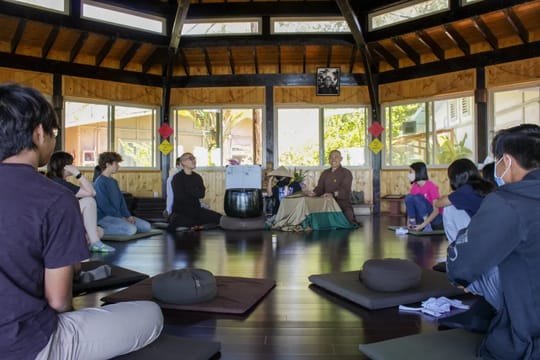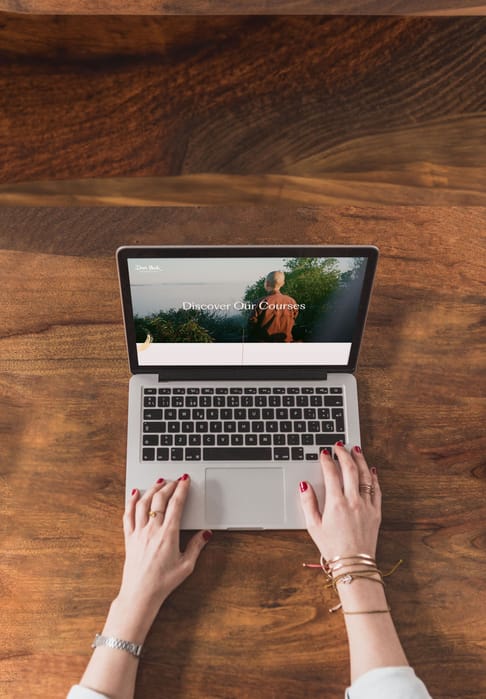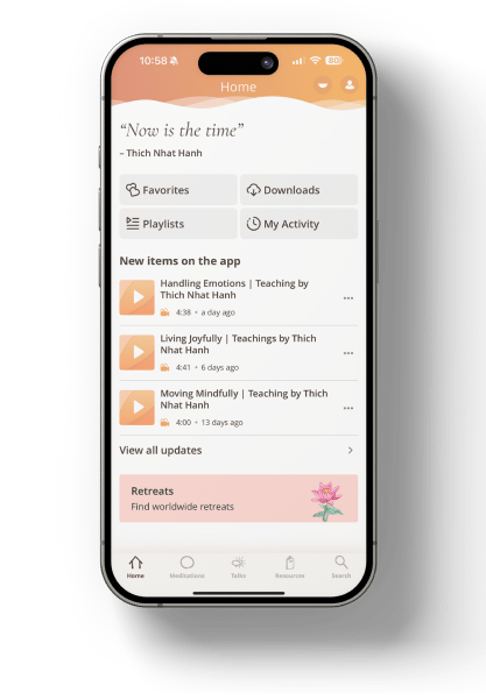Guided Meditation Exercise 02
Total Relaxation

Total Relaxation


Turn Your Inbox into a Dharma Door
Subscribe to our Coyote Tracks newsletter on Substack to receive event announcements, writing, art, music, and meditations from Deer Park monastics.
Support Deer Park
Donations are our main source of support, so every offering is greatly appreciated. Your contribution helps us to keep the monastery open to receive guests throughout the year.
DonateBreathing in, I know I am breathing in / In
Breathing out, I know I am breathing out / Out
Breathing in, my breath grows deep / Deep
Breathing out, my breath grows slow / Slow
Breathing in, I am aware of my whole body / Aware
Breathing out, I relax my whole body / Relax
Breathing in, I calm my whole body / Calm
Breathing out, I care for my whole body / Caring
Breathing in, I smile to my whole body / Smile
Breathing out, I feel my body at ease / At ease
Breathing in, I smile to my whole body / Smile
Breathing out, I let go completely / Let go
Breathing in, I feel joy / Joy
Breathing out, I taste the source of peace / Peace
Breathing in, I dwell in the present moment / Present moment
Breathing out, the present moment is wonderful / Wonderful
Breathing in, my sitting is solid / Solid
Breathing out, I feel stable and secure / Stable
This exercise is simple, yet its effects are profound. It allows beginners to taste the peace and joy of meditation. Even experienced practitioners continue to practice it to nourish body and mind, providing a strong foundation for further progress.
The first breath (In, Out) is to recognize the breath. If it is an in-breath, practitioners know it is an in-breath. If it is an out-breath, they recognize it as an out-breath. Practicing in this way for a few breaths naturally stops thoughts of the past and worries about the future, bringing an end to distractions. This happens because practitioners’ minds become fully engaged with the breath—at that moment, the mind is no longer anxious or restless but becomes the mind of breathing.
The second breath (Deep, Slow) helps us notice that our in-breath has naturally deepened and our out-breath has slowed down. This happens effortlessly, without any force. When we breathe mindfully, our breath naturally becomes more refined. When the breath becomes steady and peaceful, the practitioner begins to experience a deep sense of ease in both body and mind. The calming of the breath leads to the calming of the whole being. At this stage, the practitioner experiences meditative joy (dhyāna delight).
The third breath (Aware of my whole body, Relaxing my whole body) helps bring awareness back to the body. The breath acts as a bridge connecting body and mind. The out-breath carries the function of relaxing the entire body. As we breathe out, we release tension in the shoulders, arms, and throughout the body, allowing a deep sense of ease to enter. This breath should be practiced at least ten times.
The fourth breath (Calming the whole body, Caring for the whole body) quiets the physiological processes within the body (as described in the Satipaṭṭhāna Sutta). Through the out-breath, practitioners express care and kindness toward their own bodies, fostering a sense of compassion and deep healing.
The fifth breath (Smiling to my whole body, Feeling at ease) allows the facial muscles to relax through a gentle smile. This smile extends to the entire body, like a cool stream flowing through. Feeling at ease means bringing lightness and comfort to the body and mind. This breath nurtures the whole being with tenderness and self-care.
The sixth breath (Smiling to my whole body, Letting go completely) continues the previous breath, helping dissolve any remaining tension in the body.
The seventh breath (Feeling joy, Tasting the source of peace) allows the practitioner to feel joy at being alive—healthy, able to care for and nourish the body and mind. The out-breath carries the taste of happiness. True happiness is simple. Sitting peacefully and breathing mindfully can already be a great source of happiness. Many people are caught in the busyness of life and do not have the opportunity to taste this deep peace.
The eighth breath (Dwelling in the present moment, The present moment is wonderful) helps practitioners rest fully in the present moment. The Buddha taught: “The past is gone, the future has not yet come; life is only available in the present moment.” When we touch the present deeply, we encounter the wonders of life—peace, liberation, the Buddha nature, and Nirvana. These are all present in the here and now. The out-breath brings a sense of joy, leading the practitioner to exclaim, "The present moment is wonderful!"
The ninth breath (My sitting is solid, I feel stable and secure) brings awareness to the stability of our posture. If our sitting is not yet steady, it naturally becomes more upright and balanced. A solid sitting posture cultivates a sense of stability and deep security in the mind. In such a sitting, practitioners become masters of their bodies and minds, no longer being carried away by unwholesome habits of thought, speech, or action.
From time to time we offer multi-week courses related to mindfulness, the teachings and life of Thich Nhat Hanh, and a variety of similar subjects. Please see our schedule of upcoming courses.

Take the Deer Park Monastery and Plum Village community with you wherever you go. The Plum Village app is designed to cultivate mindfulness, compassion, and joy through guided meditations, deep relaxations, practice poems, bells of mindfulness, and other practices — all through a mobile device.
